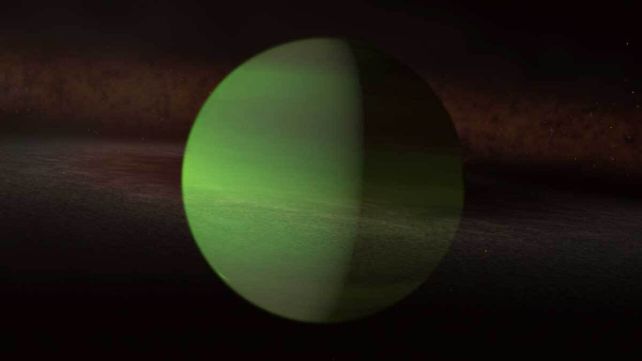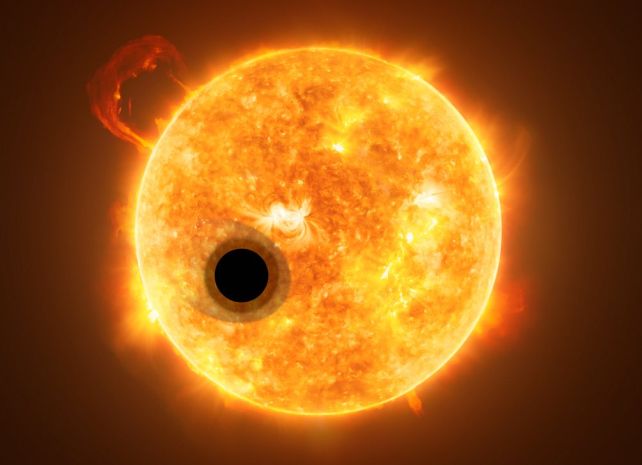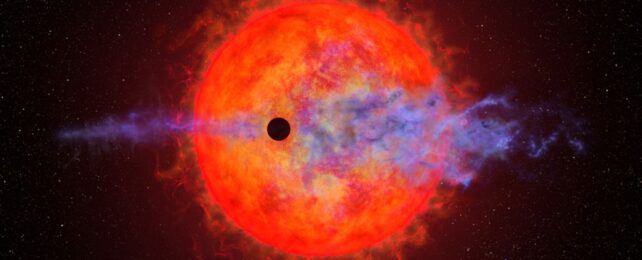A young star is lashing its orbiting exoplanet with so much fury that it's sporadically ripping away vast amounts of atmosphere.
The exoplanet is AU Microscopii b (or AU Mic b), and it's orbiting a very young red dwarf star just 32 light-years from Earth. The system is just 23 million years old, practically a baby, and its wild behavior offers a rare glimpse into the turbulent early life of newly formed planets.
What's super interesting about the Neptune-sized world is that the atmospheric escape is not constant. Instead, it seems to rapidly switch on, going from detectable to undetectable in the course of a single orbit. And when it was detectable, the atmosphere seemed to be leaking in front of the exoplanet rather than trailing behind it.
"When I first saw this, I thought, 'That can't be right'," says astronomer Keighley Rockcliffe of Dartmouth College, who led the research.
"This frankly strange observation is kind of a stress-test case for the modeling and the physics about planetary evolution. This observation is so cool because we're getting to probe this interplay between the star and the planet that is really at the most extreme."

AU Mic b was discovered in 2020, and even then, scientists knew it had to be interesting. It's a little bigger than Neptune, clocking in at 20.12 Earth masses and 4.19 Earth radii; Neptune is 17.15 Earth masses and 3.88 Earth radii. Unlike Neptune, though, AU Mic b is very close to its star: One orbit is just 8.5 days.
That proximity gives the exoplanet a front-row seat to the star's belligerent behavior, and boy, is it ever rowdy. Young stars are much more active than older, more sedate, and established ones, and even older red dwarfs are pretty active.
AU Mic is positively rampant with activity, spitting out more than 6 flares a day. It's just a constant onslaught of wild stellar winds and flares and harsh X-ray light.
Rockcliffe and her team wanted to take a closer look at the exoplanet because it might help explain a curious gap in exoplanet detections, worlds between 1.5 and 2 times the radius of Earth in close proximity to their stars.
AU Mic b is on the larger side of this gap, but if it is actively losing its atmosphere – and thus shrinking – it could shed light on the mechanisms that produce the gap. Young worlds thrashed by tempestuous stars could cause them to lose their atmospheres and shrink. Larger worlds might have enough gravity to retain a thick atmosphere; smaller ones just become bare rocks.

"We want to find out what kinds of planets can survive these environments," Rockcliffe explains.
"What will they finally look like when the star settles down? … We don't really know what those final compositions look like because we don't have anything like that in our Solar System."
It's unclear exactly what is happening with AU Mic b, but whatever it is, it's a lot. It seems like all the mechanisms for atmospheric stripping are happening at the same time, which means it's an excellent laboratory for studying what an exoplanet can weather.
As for the on-again, off-again, planet-leading hydrogen detection, there could be a few reasons. Stellar flares could ionize the hydrogen, rendering it invisible to our telescopes. It's still there, we just can't see it. And powerful stellar winds could guide where it goes, pushing it out in front of AU Mic b rather than letting it trail behind.
Whatever is going on, continuing to study it will be valuable.
"Knowing how atmospheres evolve and which planets will have stable atmospheres is important for finding life on other planets," Rockcliffe says. "Atmospheres are essential in understanding how life can form and persist."
The research has been published in The Astronomical Journal.
